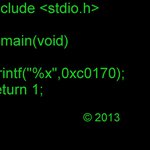mbed library sources. Supersedes mbed-src.
Dependents: Nucleo_Hello_Encoder BLE_iBeaconScan AM1805_DEMO DISCO-F429ZI_ExportTemplate1 ... more
targets/TARGET_STM/TARGET_STM32L0/device/stm32l0xx_hal_tim_ex.c
- Committer:
- AnnaBridge
- Date:
- 2019-02-20
- Revision:
- 189:f392fc9709a3
- Parent:
- 186:707f6e361f3e
File content as of revision 189:f392fc9709a3:
/**
******************************************************************************
* @file stm32l0xx_hal_tim_ex.c
* @author MCD Application Team
* @brief TIM HAL module driver.
* @brief This file provides firmware functions to manage the following
* functionalities of the Timer (TIM) peripheral:
* + Time Hall Sensor Interface Initialization
* + Time Hall Sensor Interface Start
* + Time Master and Slave synchronization configuration
@verbatim
================================================================================
##### TIM specific features integration #####
================================================================================
[..] The Timer features include:
(#) 16-bit up, down, up/down auto-reload counter.
(#) 16-bit programmable prescaler allowing dividing (also on the fly) the counter clock
frequency either by any factor between 1 and 65536.
(#) Up to 4 independent channels for:
Input Capture
Output Compare
PWM generation (Edge and Center-aligned Mode)
One-pulse mode output
(#) Synchronization circuit to control the timer with external signals and to interconnect
several timers together.
(#) Supports incremental (quadrature) encoder and hall-sensor circuitry for positioning
purposes
##### How to use this driver #####
================================================================================
[..]
(#) Enable the TIM interface clock using
__HAL_RCC_TIMx_CLK_ENABLE();
(#) TIM pins configuration
(++) Enable the clock for the TIM GPIOs using the following function:
__HAL_RCC_GPIOx_CLK_ENABLE();
(++) Configure these TIM pins in Alternate function mode using HAL_GPIO_Init();
(#) The external Clock can be configured, if needed (the default clock is the internal clock from the APBx),
using the following function:
HAL_TIM_ConfigClockSource, the clock configuration should be done before any start function.
(#) Configure the TIM in the desired operating mode using one of the
configuration function of this driver:
(++) HAL_TIMEx_MasterConfigSynchronization() to configure the peripheral in master mode.
(#) Remap the Timer I/O using HAL_TIMEx_RemapConfig() API.
@endverbatim
******************************************************************************
* @attention
*
* <h2><center>© COPYRIGHT(c) 2016 STMicroelectronics</center></h2>
*
* Redistribution and use in source and binary forms, with or without modification,
* are permitted provided that the following conditions are met:
* 1. Redistributions of source code must retain the above copyright notice,
* this list of conditions and the following disclaimer.
* 2. Redistributions in binary form must reproduce the above copyright notice,
* this list of conditions and the following disclaimer in the documentation
* and/or other materials provided with the distribution.
* 3. Neither the name of STMicroelectronics nor the names of its contributors
* may be used to endorse or promote products derived from this software
* without specific prior written permission.
*
* THIS SOFTWARE IS PROVIDED BY THE COPYRIGHT HOLDERS AND CONTRIBUTORS "AS IS"
* AND ANY EXPRESS OR IMPLIED WARRANTIES, INCLUDING, BUT NOT LIMITED TO, THE
* IMPLIED WARRANTIES OF MERCHANTABILITY AND FITNESS FOR A PARTICULAR PURPOSE ARE
* DISCLAIMED. IN NO EVENT SHALL THE COPYRIGHT HOLDER OR CONTRIBUTORS BE LIABLE
* FOR ANY DIRECT, INDIRECT, INCIDENTAL, SPECIAL, EXEMPLARY, OR CONSEQUENTIAL
* DAMAGES (INCLUDING, BUT NOT LIMITED TO, PROCUREMENT OF SUBSTITUTE GOODS OR
* SERVICES; LOSS OF USE, DATA, OR PROFITS; OR BUSINESS INTERRUPTION) HOWEVER
* CAUSED AND ON ANY THEORY OF LIABILITY, WHETHER IN CONTRACT, STRICT LIABILITY,
* OR TORT (INCLUDING NEGLIGENCE OR OTHERWISE) ARISING IN ANY WAY OUT OF THE USE
* OF THIS SOFTWARE, EVEN IF ADVISED OF THE POSSIBILITY OF SUCH DAMAGE.
*
******************************************************************************
*/
/* Includes ------------------------------------------------------------------*/
#include "stm32l0xx_hal.h"
/** @addtogroup STM32L0xx_HAL_Driver
* @{
*/
/** @addtogroup TIMEx
* @brief TIMEx HAL module driver
* @{
*/
#ifdef HAL_TIM_MODULE_ENABLED
/** @addtogroup TIMEx_Exported_Functions
* @{
*/
/** @addtogroup TIMEx_Exported_Functions_Group1
* @brief Peripheral Control functions
*
@verbatim
===============================================================================
##### Peripheral Control functions #####
===============================================================================
[..] This section provides functions allowing to:
(+) Configure Master and the Slave synchronization.
@endverbatim
* @{
*/
/**
* @brief Configures the TIM in master mode.
* @param htim: TIM handle.
* @param sMasterConfig: pointer to a TIM_MasterConfigTypeDef structure that
* contains the selected trigger output (TRGO) and the Master/Slave
* mode.
* @retval HAL status
*/
HAL_StatusTypeDef HAL_TIMEx_MasterConfigSynchronization(TIM_HandleTypeDef *htim, TIM_MasterConfigTypeDef * sMasterConfig)
{
/* Check the parameters */
assert_param(IS_TIM_MASTER_INSTANCE(htim->Instance));
assert_param(IS_TIM_TRGO_SOURCE(sMasterConfig->MasterOutputTrigger));
assert_param(IS_TIM_MSM_STATE(sMasterConfig->MasterSlaveMode));
__HAL_LOCK(htim);
/* Change the handler state */
htim->State = HAL_TIM_STATE_BUSY;
/* Reset the MMS Bits */
htim->Instance->CR2 &= ~TIM_CR2_MMS;
/* Select the TRGO source */
htim->Instance->CR2 |= sMasterConfig->MasterOutputTrigger;
/* Reset the MSM Bit */
htim->Instance->SMCR &= ~TIM_SMCR_MSM;
/* Set or Reset the MSM Bit */
htim->Instance->SMCR |= sMasterConfig->MasterSlaveMode;
htim->State = HAL_TIM_STATE_READY;
__HAL_UNLOCK(htim);
return HAL_OK;
}
#if defined (STM32L071xx) || defined (STM32L072xx) || defined (STM32L073xx) \
|| defined (STM32L081xx) || defined (STM32L082xx) || defined (STM32L083xx)
/**
* @brief Configures the remapping of the TIM2, TIM3, TIM21 and TIM22 inputs.
* The channel inputs (T1..T4) and the Trigger input (ETR) of the
* timers can be remaped thanks to this function. When an input is
* mapped, on a GPIO, refer yourself to the GPIO alternate functions
* for more details.
* @note It is not possible to connect TIM2 and TIM21 on
* GPIOB5_AF4 at the same time.
* When selecting TIM3_TI2_GPIOB5_AF4, Channel2 of TIM3 will be
* connected to GPIOB5_AF4 and Channel2 of TIM22 will be connected to
* some other GPIOs. (refer to alternate functions for more details)
* When selecting TIM3_TI2_GPIO_DEF, Channel2 of Timer 3 will be
* connected an GPIO (other than GPIOB5_AF4) and Channel2 of TIM22
* will be connected to GPIOB5_AF4.
*
* @param htim: pointer to a TIM_HandleTypeDef structure that contains
* the configuration information for TIM module.
* @param Remap: specifies the TIM input remapping source.
* This parameter is a combination of the following values
* depending on TIM instance:
*
* For TIM2, the parameter can have the following values:
* @arg TIM2_ETR_GPIO: TIM2 ETR connected to GPIO (default):
* GPIOA(0)_AF5 or GPIOA(5)_AF2 or
* GPIOA(15)_AF2 or GPIOE(9)_AF2
* @arg TIM2_ETR_HSI48: TIM2 ETR connected to HSI48
* @arg TIM2_ETR_HSI16: TIM2 ETR connected to HSI16
* @arg TIM2_ETR_LSE: TIM2 ETR connected to LSE
* @arg TIM2_ETR_COMP2_OUT: TIM2 ETR connected to COMP2 output
* @arg TIM2_ETR_COMP1_OUT: TIM2 ETR connected to COMP1 output
* @arg TIM2_TI4_GPIO : TIM2 TI4 connected to GPIO1(default):
* GPIOA(3)_AF2 or GPIOB(11)_AF2 or
* GPIOE(12)_AF0
* @arg TIM2_TI4_COMP1: TIM2 TI4 connected to COMP1
* @arg TIM2_TI4_COMP2: TIM2 TI4 connected to COMP2
*
* For TIM3, the parameter can have the following values:
* @arg TIM3_ETR_GPIO: TIM3 ETR connected to GPIO (default):
* GPIOE(2)_AF2 or GPIOD(2)_AF2 or
* GPIOE(2)AF2
* @arg TIM3_ETR_HSI: TIM3 ETR connected to HSI
* @arg TIM3_TI1_USB_SOF: TIM3 TI1 connected to USB_SOF (default)
* @arg TIM3_TI1_GPIO: TIM3 TI1 connected to GPIO :
* GPIOE(3)_AF2 or GPIOA(6)_AF2 or
* GPIOC(6)_AF2 or GPIOB(4)_AF2
* @arg TIM3_TI2_GPIOB5_AF4:TIM3 TI3 connected to GPIOB(5)_AF4
* (refer to note)
* @arg TIM3_TI2_GPIO_DEF: TIM3 TI3 connected to GPIO (default):
* GPIO_A(7)_AF2 or GPIO_B(5)_AF4 or
* GPIOC(7)_AF2 or GPIOE(7)_AF2
* @arg TIM3_TI4_GPIO_DEF: TIM3 TI4 connected to GPIO:
* GPIO_B(1)_AF2 or GPIO_E(6)_AF2
* @arg TIM3_TI4_GPIOC9_AF2:TIM3 TI4 connected to GPIOC(9)_AF2
*
* For TIM21, the parameter can have the following values:
* @arg TIM21_ETR_GPIO: TIM21 ETR connected to GPIO(default) :
* APB2_PC(9)_AF0 or APB2_PA(1)_AF5
* @arg TIM21_ETR_COMP2_OUT:TIM21 ETR connected to COMP2 output
* @arg TIM21_ETR_COMP1_OUT:TIM21 ETR connected to COMP1 output
* @arg TIM21_ETR_LSE: TIM21 ETR connected to LSE
* @arg TIM21_TI1_MCO: TIM21 TI1 connected to MCO
* @arg TIM21_TI1_RTC_WKUT_IT: TIM21 TI1 connected to RTC WAKEUP interrupt
* @arg TIM21_TI1_HSE_RTC: TIM21 TI1 connected to HSE_RTC
* @arg TIM21_TI1_MSI: TIM21 TI1 connected to MSI clock
* @arg TIM21_TI1_LSE: TIM21 TI1 connected to LSE
* @arg TIM21_TI1_LSI: TIM21 TI1 connected to LSI
* @arg TIM21_TI1_COMP1_OUT:TIM21 TI1 connected to COMP1_OUT
* @arg TIM21_TI1_GPIO: TIM21 TI1 connected to GPIO(default):
* GPIOA(2)_AF0 or GPIOB(13)_AF6 or
* GPIOE(5)_AF0 or GPIOD(0)_AF0
* @arg TIM21_TI2_GPIO: TIM21 TI2 connected to GPIO(default):
* GPIOA(3)_AF0 or GPIOB(14)_AF6 or
* GPIOE(6)_AF0 or GPIOD(7)_AF1
* @arg TIM21_TI2_COMP2_OUT:TIM21 TI2 connected to COMP2 output
*
* For TIM22, the parameter can have the following values:
* @arg TIM22_ETR_LSE: TIM22 ETR connected to LSE
* @arg TIM22_ETR_COMP2_OUT:TIM22 ETR connected to COMP2 output
* @arg TIM22_ETR_COMP1_OUT:TIM22 ETR connected to COMP1 output
* @arg TIM22_ETR_GPIO: TIM22 ETR connected to GPIO(default):
* GPIOC(8)_AF0 or GPIOA(4)_AF5
* @arg TIM22_TI1_GPIO1: TIM22 TI1 connected to GPIO(default):
* GPIOC(6)_AF0 or GPIOA(6)_AF5 or
* GPIOB(4)_AF4 or GPIOE(0)_AF3
* @arg TIM22_TI1_COMP2_OUT:TIM22 TI1 connected to COMP2 output
* @arg TIM22_TI1_COMP1_OUT:TIM22 TI1 connected to COMP1 output
* @arg TIM22_TI1_GPIO2: TIM22 TI1 connected to GPIO:
* GPIOC(6)_AF0 or GPIOA(6)_AF5 or
* GPIOB(4)_AF4 or GPIOE(3)_AF0
*
* @retval HAL status
*/
#elif defined (STM32L031xx) || defined (STM32L041xx)
/**
* @brief Configures the remapping of the TIM2, TIM21 and TIM22 inputs.
* The channel inputs (T1..T4) and the Trigger input (ETR) of the
* timers can be remaped thanks to this function. When an input is
* mapped, on a GPIO, refer yourself to the GPIO alternate functions
* for more details.
*
* @param htim: pointer to a TIM_HandleTypeDef structure that contains
* the configuration information for TIM module.
* @param Remap: specifies the TIM input remapping source.
* This parameter is a combination of the following values
* depending on TIM instance:
*
* For TIM2, the parameter can have the following values:
* @arg TIM2_ETR_GPIO: TIM2 ETR connected to GPIO (default):
* GPIOA(0)_AF5 or GPIOA(5)_AF2 or
* GPIOA(15)_AF2
* @arg TIM2_ETR_HSI16: TIM2 ETR connected to HS16 (HSIOUT)
* @arg TIM2_ETR_LSE: TIM2 ETR connected to LSE
* @arg TIM2_ETR_COMP2_OUT: TIM2 ETR connected to COMP2 output
* @arg TIM2_ETR_COMP1_OUT: TIM2 ETR connected to COMP1 output
* @arg TIM2_TI4_GPIO : TIM2 TI4 connected to GPIO (default):
* GPIOA(3)_AF2 or GPIOB(11)_AF2 or
* GPIOB(1)_AF5
* @arg TIM2_TI4_COMP1_OUT: TIM2 TI4 connected to COMP1 output
* @arg TIM2_TI4_COMP2_OUT: TIM2 TI4 connected to COMP2 output
*
* For TIM21, the parameter can have the following values:
* @arg TIM21_ETR_GPIO: TIM21 ETR connected to GPIO(default) :
* APB2_PA(1)_AF5
* @arg TIM21_ETR_COMP2_OUT:TIM21 ETR connected to COMP2 output
* @arg TIM21_ETR_COMP1_OUT:TIM21 ETR connected to COMP1 output
* @arg TIM21_ETR_LSE: TIM21 ETR connected to LSE
* @arg TIM21_TI1_MCO: TIM21 TI1 connected to MCO
* @arg TIM21_TI1_RTC_WKUT_IT: TIM21 TI1 connected to RTC WAKEUP interrupt
* @arg TIM21_TI1_HSE_RTC: TIM21 TI1 connected to HSE_RTC
* @arg TIM21_TI1_MSI: TIM21 TI1 connected to MSI clock
* @arg TIM21_TI1_LSE: TIM21 TI1 connected to LSE
* @arg TIM21_TI1_LSI: TIM21 TI1 connected to LSI
* @arg TIM21_TI1_COMP1_OUT:TIM21 TI1 connected to COMP1_OUT
* @arg TIM21_TI2_GPIO: TIM21 TI2 connected to GPIO(default):
* GPIOA(3)_AF0 or GPIOB(14)_AF6
* @arg TIM21_TI2_COMP2_OUT:TIM21 TI2 connected to COMP2 output
*
* For TIM22, the parameter can have the following values:
* @arg TIM22_ETR_LSE: TIM22 ETR connected to LSE
* @arg TIM22_ETR_COMP2_OUT:TIM22 ETR connected to COMP2 output
* @arg TIM22_ETR_COMP1_OUT:TIM22 ETR connected to COMP1 output
* @arg TIM22_ETR_GPIO: TIM22 ETR connected to GPIO(default):
* GPIOA(4)_AF5
* @arg TIM22_TI1_GPIO1: TIM22 TI1 connected to GPIO(default):
* GPIOC(0)_AF6 or GPIOA(5)_AF6 or
* GPIOB(4)_AF4
* @arg TIM22_TI1_COMP2_OUT:TIM22 TI1 connected to COMP2 output
* @arg TIM22_TI1_COMP1_OUT:TIM22 TI1 connected to COMP1 output
* @arg TIM22_TI1_GPIO2: TIM22 TI1 connected to GPIO:
* GPIOA(6)_AF5 or GPIOB(4)_AF4
*
* @retval HAL status
*/
#elif defined (STM32L011xx) || defined (STM32L021xx)
/**
* @brief Configures the remapping of the TIM2 and TIM21 inputs.
* The channel inputs (T1..T4) and the Trigger input (ETR) of the
* timers can be remaped thanks to this function. When an input is
* mapped, on a GPIO, refer yourself to the GPIO alternate functions
* for more details.
*
* @param htim: pointer to a TIM_HandleTypeDef structure that contains
* the configuration information for TIM module.
* @param Remap: specifies the TIM input remapping source.
* This parameter is a combination of the following values
* depending on TIM instance:
*
* For TIM2, the parameter can have the following values:
* @arg TIM2_ETR_GPIO: TIM2 ETR connected to GPIO (default):
* GPIOA(0)_AF5 or GPIOA(5)_AF2 or
* GPIOA(15)_AF2
* @arg TIM2_ETR_HSI16: TIM2 ETR connected to HS16 (HSIOUT)
* @arg TIM2_ETR_LSE: TIM2 ETR connected to LSE
* @arg TIM2_ETR_COMP2_OUT: TIM2 ETR connected to COMP2 output
* @arg TIM2_ETR_COMP1_OUT: TIM2 ETR connected to COMP1 output
* @arg TIM2_TI4_GPIO : TIM2 TI4 connected to GPIO (default):
* GPIOA(3)_AF2 or GPIOB(11)_AF2 or
* GPIOB(1)_AF5
* @arg TIM2_TI4_COMP1_OUT: TIM2 TI4 connected to COMP1 output
* @arg TIM2_TI4_COMP2_OUT: TIM2 TI4 connected to COMP2 output
*
* For TIM21, the parameter can have the following values:
* @arg TIM21_ETR_GPIO: TIM21 ETR connected to GPIO(default) :
* APB2_PA(1)_AF5
* @arg TIM21_ETR_COMP2_OUT:TIM21 ETR connected to COMP2 output
* @arg TIM21_ETR_COMP1_OUT:TIM21 ETR connected to COMP1 output
* @arg TIM21_ETR_LSE: TIM21 ETR connected to LSE
* @arg TIM21_TI1_MCO: TIM21 TI1 connected to MCO
* @arg TIM21_TI1_RTC_WKUT_IT: TIM21 TI1 connected to RTC WAKEUP interrupt
* @arg TIM21_TI1_HSE_RTC: TIM21 TI1 connected to HSE_RTC
* @arg TIM21_TI1_MSI: TIM21 TI1 connected to MSI clock
* @arg TIM21_TI1_LSE: TIM21 TI1 connected to LSE
* @arg TIM21_TI1_LSI: TIM21 TI1 connected to LSI
* @arg TIM21_TI1_COMP1_OUT:TIM21 TI1 connected to COMP1_OUT
* @arg TIM21_TI2_GPIO: TIM21 TI2 connected to GPIO(default):
* GPIOA(3)_AF0 or GPIOB(14)_AF6
* @arg TIM21_TI2_COMP2_OUT:TIM21 TI2 connected to COMP2 output
*
* @retval HAL status
*/
#else
/**
* @brief Configures the remapping of the TIM2, TIM21 and TIM22 inputs.
* The channel inputs (T1..T4) and the Trigger input (ETR) of the
* timers can be remaped thanks to this function. When an input is
* mapped, on a GPIO, refer yourself to the GPIO alternate functions
* for more details.
*
* @param htim: pointer to a TIM_HandleTypeDef structure that contains
* the configuration information for TIM module.
* @param Remap: specifies the TIM input remapping source.
* This parameter is a combination of the following values
* depending on TIM instance:
*
* For TIM2, the parameter can have the following values:
* @arg TIM2_ETR_GPIO: TIM2 ETR connected to GPIO (default):
* GPIOA(0)_AF5 or GPIOA(5)_AF2 or
* GPIOA(15)_AF2 or GPIOE(9)_AF2
* @arg TIM2_ETR_HSI48: TIM2 ETR connected to HSI48
* @arg TIM2_ETR_LSE: TIM2 ETR connected to LSE
* @arg TIM2_ETR_COMP2_OUT: TIM2 ETR connected to COMP2 output
* @arg TIM2_ETR_COMP1_OUT: TIM2 ETR connected to COMP1 output
* @arg TIM2_TI4_GPIO: TIM2 TI4 connected to GPIO1(default):
* GPIOA(3)_AF2 or GPIOB(11)_AF2 or
* GPIOE(12)_AF0
* @arg TIM2_TI4_COMP1: TIM2 TI4 connected to COMP1
* @arg TIM2_TI4_COMP2: TIM2 TI4 connected to COMP2
* @arg TIM2_TI4_GPIO2: TIM2 TI4 connected to GPIO2 :
* GPIOA(3)_AF2 or GPIOB(11)_AF2 or
* GPIOE(12)_AF0
*
* For TIM21, the parameter can have the following values:
* @arg TIM21_ETR_GPIO: TIM21 ETR connected to GPIO(default) :
* APB2_PC(9)_AF0 or APB2_PA(1)_AF5
* @arg TIM21_ETR_COMP2_OUT:TIM21 ETR connected to COMP2 output
* @arg TIM21_ETR_COMP1_OUT:TIM21 ETR connected to COMP1 output
* @arg TIM21_ETR_LSE: TIM21 ETR connected to LSE
* @arg TIM21_TI1_MCO: TIM21 TI1 connected to MCO
* @arg TIM21_TI1_RTC_WKUT_IT: TIM21 TI1 connected to RTC WAKEUP interrupt
* @arg TIM21_TI1_HSE_RTC: TIM21 TI1 connected to HSE_RTC
* @arg TIM21_TI1_MSI: TIM21 TI1 connected to MSI clock
* @arg TIM21_TI1_LSE: TIM21 TI1 connected to LSE
* @arg TIM21_TI1_LSI: TIM21 TI1 connected to LSI
* @arg TIM21_TI1_COMP1_OUT:TIM21 TI1 connected to COMP1_OUT
* @arg TIM21_TI1_GPIO: TIM21 TI1 connected to GPIO(default):
* GPIOA(2)_AF0 or GPIOB(13)_AF6 or
* GPIOE(5)_AF0 or GPIOD(0)_AF0
* @arg TIM21_TI2_GPIO: TIM21 TI2 connected to GPIO(default):
* GPIOA(3)_AF0 or GPIOB(14)_AF6 or
* GPIOE(6)_AF0 or GPIOD(7)_AF1
* @arg TIM21_TI2_COMP2_OUT:TIM21 TI2 connected to COMP2 output
*
* For TIM22, the parameter can have the following values:
* @arg TIM22_ETR_LSE: TIM22 ETR connected to LSE
* @arg TIM22_ETR_COMP2_OUT:TIM22 ETR connected to COMP2 output
* @arg TIM22_ETR_COMP1_OUT:TIM22 ETR connected to COMP1 output
* @arg TIM22_ETR_GPIO: TIM22 ETR connected to GPIO(default):
* GPIOC(8)_AF0 or GPIOA(4)_AF5
* @arg TIM22_TI1_GPIO1: TIM22 TI1 connected to GPIO(default):
* GPIOC(6)_AF0 or GPIOA(6)_AF5 or
* GPIOB(4)_AF4 or GPIOE(0)_AF3
* @arg TIM22_TI1_COMP2_OUT:TIM22 TI1 connected to COMP2 output
* @arg TIM22_TI1_COMP1_OUT:TIM22 TI1 connected to COMP1 output
* @arg TIM22_TI1_GPIO2: TIM22 TI1 connected to GPIO:
* GPIOC(6)_AF0 or GPIOA(6)_AF5 or
* GPIOB(4)_AF4 or GPIOE(3)_AF0
*
* @retval HAL status
*/
#endif /* STM32L07xxx or STM32L08xxx */
HAL_StatusTypeDef HAL_TIMEx_RemapConfig(TIM_HandleTypeDef *htim, uint32_t Remap)
{
__HAL_LOCK(htim);
/* Check parameters */
assert_param(IS_TIM_REMAP(htim->Instance,Remap));
/* Set the Timer remapping configuration */
htim->Instance->OR = Remap;
htim->State = HAL_TIM_STATE_READY;
__HAL_UNLOCK(htim);
return HAL_OK;
}
/**
* @}
*/
/**
* @}
*/
#endif /* HAL_TIM_MODULE_ENABLED */
/**
* @}
*/
/**
* @}
*/
/************************ (C) COPYRIGHT STMicroelectronics *****END OF FILE****/
 mbed official
mbed official




